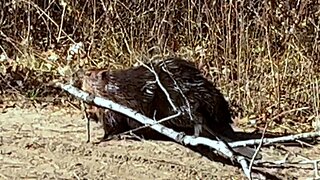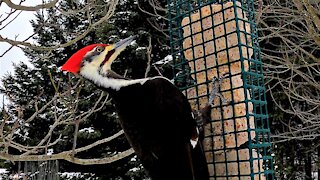Premium Only Content

Fastest land animal in the Western Hemisphere captured by drone
Pronghorn antelope are the fastest land animals in North America. They are even the fastest in the entire Western Hemisphere. They are known as prairie antelope, American antelope, and prong buck. Their closest relative is actually the giraffe and okapi. They are capable of running speeds of 89kmh (55mph). The only animal on the planet that is capable of higher running speeds is the African cheetah, although the pronghorn can maintain a high speed for a longer period.
They can be found in the interior western United States and parts of the prairie provinces in Canada. Much faster than any predator in this hemisphere, it is believed that it evolved with this running ability to escape the now extinct American cheetah.
These pronghorns were seen running across the Badlands of Saskatchewan, Canada. A drone was being used to film the nearby salt flats when the pronghorns came running through. A wolf was seen along a fence line far behind the pronghorns. Other wolves could be heard barking excitedly. The pronghorns had either heard or smelled the predators and they quickly made their way out of the area. The wolves could never catch healthy pronghorns with open space to run.
Once abundant in North America, pronghorns were hunted by indigenous people to provide a staple part of their diet. These animals are timid and they run at the first sight of a human, making them very difficult to kill. Early tribes would create fenced areas or pens with sticks and branches and they would surround the pronghorns, gently driving them toward an enclosed area. They are reluctant to leap obstacles so they could be more easily shot with arrows once they were herded into an enclosed area.
During breeding seasons, females spend time with one male and then switch to another, inciting conflict and aggression. The males fight for dominance and the females will then mate with the winner.
Although these beautiful animals faced a dangerous population decline soon after the turn of the century, conservation efforts have helped their populations increase over the last 100 years. Although still a species of concern due to habitat encroachment, their numbers are no longer decreasing.
-
 3:21
3:21
WildCreatures
1 month ago $0.58 earnedHiker Encounters Beaver in the Woods Hauling His Dinner to the Pond
3.2K1 -
 0:14
0:14
ViralHog
3 years ago $0.22 earnedWedge-Tailed Eagle Swoops at Drone
1.09K3 -
 0:13
0:13
crocodiletour
3 years ago $10.39 earnedHere's why this animal is known as the 'Jesus lizard'
7.35K17 -
 2:40
2:40
galwaycinematography
3 years agoIrish drone footages captures feeding basking shark
1.35K28 -
 1:19
1:19
WildCreatures
3 years ago $2.28 earnedHigh altitude drone shows devastation from gypsy moth caterpillars
6.19K39 -
 1:08
1:08
WildCreatures
3 years ago $168.87 earnedGigantic woodpecker captured by camera mounted by bird feeder
270K111 -
 1:13
1:13
Reuters
3 years agoTaliban convoy parades captured Western assets
84220 -
 59:44
59:44
PMG
1 day ago $0.16 earned"BETRAYAL - Johnson's New Spending Bill EXPANDS COVID Plandemic Powers"
16.5K -
 6:48:50
6:48:50
Akademiks
12 hours agoKendrick Lamar and SZA disses Drake and BIG AK? HOLD UP! Diddy, Durk, JayZ update. Travis Hunter RUN
141K22 -
 11:45:14
11:45:14
Right Side Broadcasting Network
9 days agoLIVE REPLAY: TPUSA's America Fest Conference: Day Three - 12/21/24
321K28